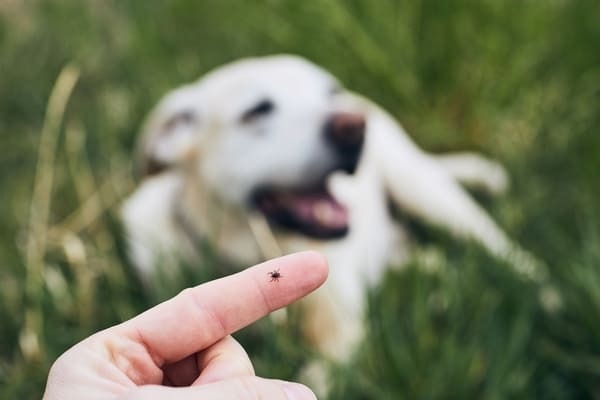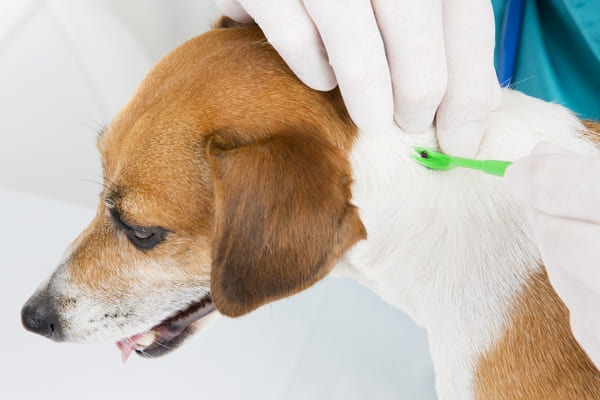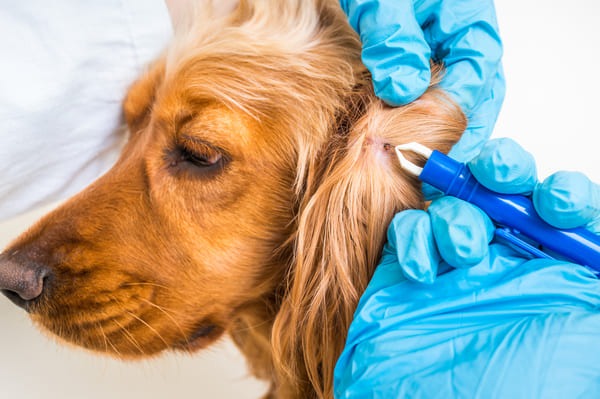

9 Steps For Removing Ticks From Dogs
If you’re hiking in tick-heavy areas, you’ll likely take precautions such as donning high socks or dousing yourself in parasite repellent. What if you’ll be bringing your dog along for the trip? Blood-sucking parasites like ticks are attracted to dogs too, potentially causing adverse health reactions. Here’s how you can handle it.

Writer Animalia Team
5 min read

The best way to protect dogs is to minimize the likelihood of pests attaching themselves in the first place. Pest prevention products go a long way in avoiding tick-borne conditions and medical mishaps. Even responsible pet owners can’t plan for everything. What should you do if a tick manages to attach itself to your pet? Here are 9 key steps to follow.
1. Keep your dog calm and relaxed
Keeping your dog calm and relaxed is the first essential step for successfully addressing a tick bite. Hold your dog firmly and speak in a clear, calm voice to address their anxiety. If possible, remove your dog to an area that’s free from other people and pets.
Tip: You should always wear gloves when handling your dog for medical purposes. This will keep you both safer.
2. Learn to identify ticks and symptoms of tick-borne disease
For the sake of your dog’s health, it is vital to learn how to identify ticks and signs of tick-borne diseases. Ticks are small, brown, oval-shaped arthropods that can be found in various sizes.
If a tick is alive, you’ll see visible legs and the head. A thorough visual inspection is the best way to identify ticks on your dog. Look for small, dark, oval-shaped bumps on your dog’s fur. Though you’ll need to look very closely, the naked eye is typically sufficient. Be sure to check hidden areas like your dog’s ears and groin and between their toes.
Once you find the parasites, check for signs of redness, swelling, pus, or irritation. These could indicate that the tick has been present and feasting away for some time. It is also important to watch your dog for any signs of tick-borne diseases. Common symptoms include:
- Fever
- Lethargy
- Loss of appetite
- Joint pain
- Swollen lymph nodes
If you notice any of these symptoms, contact your veterinarian right away to mount a corrective response. Always check your dog for ticks after each walk or outdoor adventure to be safe.
3. Scan for ticks
Regularly scanning for ticks and other parasites is a crucial part of keepings pets safe. It’s important to check your pet regularly, as ticks can find a home anywhere on their body. After spending time outdoors with your pup, take a few minutes to run your hands over their coat and skin. Save time for all areas, paying particular attention to dark, out-of-sight spots a tick might favor. If you find a tick, you’ll need the right equipment to remove it.

4. Gather your equipment
Having the right tick removal equipment is critical for successful tick removal. You should have tweezers and a tick removal tool on hand. Specialized tick removal tools are available at pet stores or online.
5. Safely remove the tick
Without causing any additional harm or upsetting your dog, remove the tick as quickly as possible. First, grasp the tick with the removal tool or tweezers as close to the skin as possible. Next, pull the tick out slowly, steadily, and in a straight line while applying even pressure.
If you’re using tweezers, clamp down on the tick’s head, not its body. Take care not to squeeze the tick too hard, as this may cause the tick to regurgitate its contents into your dog’s skin. Once the tick is removed, disinfect the area with a mild antiseptic solution.
6. Dispose of the tick
It is essential to dispose of the tick quickly and safely. Place the tick in a small container filled with rubbing alcohol or soapy water. This will kill the tick quickly as well as any potentially harmful bacteria. Don’t squash the tick, as this could cause the tick’s body to burst. Alternatively, wrap the tick in tissue paper and then flush it down the toilet. However you dispose of the tick, keep it away from your skin and other surfaces.
7. Clean the tick bite
After disposing of the tick, the next step is to promptly and safely clean the tick bite. Use mild soap and warm water to clean and disinfect the area. Don’t scrub too hard or you may irritate your pup’s sensitive skin. After cleaning the area, apply an over-the-counter antibiotic ointment to help prevent infection.

8. Check for additional ticks on your dog
Ticks sometimes come in groups. Don’t assume your job is done because you’ve found and successfully removed a single tick. To do this, simply run your hands over your dog’s body and feel for any bumps that may point to the tick concern. If you find an additional parasite, follow the above steps to get your dog back in barking shape.
9. Practice tick prevention
Prevention is often the best and most cost effective form of treatment. Methods for keeping dogs safe from biting ticks include:
- Tick collars
- Spot treatments
- Oral medications
It’s also important to keep your yard free of tall grass, weeds, leaf piles, and other debris, which can provide a home for ticks. Regularly mowing the lawn and promptly removing debris will keep the area around your home pest free.
Protect your dog and your pet care budget with insurance
Responsible pet ownership means taking a proactive, holistic approach to health care. Checking pet insurance off your list is one way to show your dog how much you love them while getting reimbursed for eligible expenses. Get a quote today.





We offer the most
comprehensive coverage
out there
car with a spare tire for life’s bumps.
Having Animalia is like a pimped-out
Rolls Royce with a swimming pool
in the trunk.



Get your pet insurance quote
Pet type
- Dog
- Cat
What is your pet's name?
Zip code





